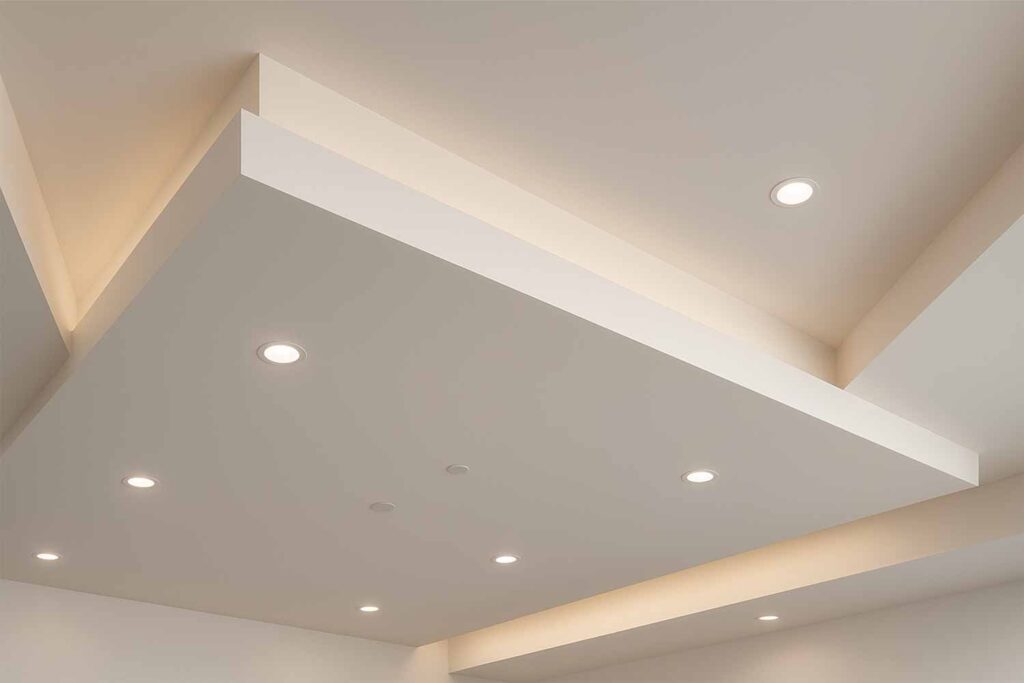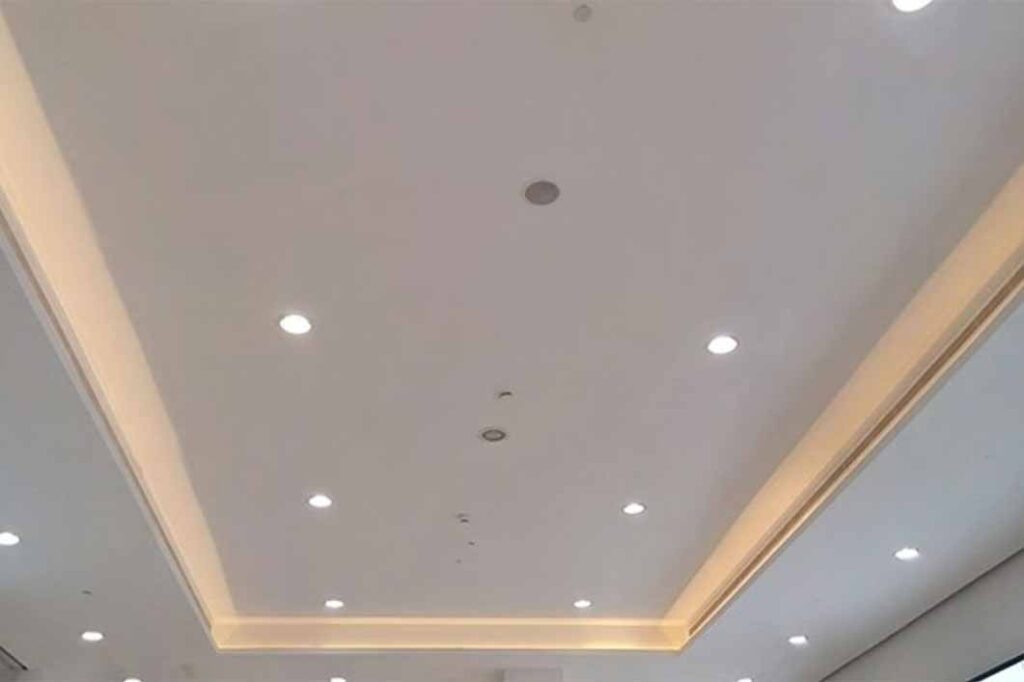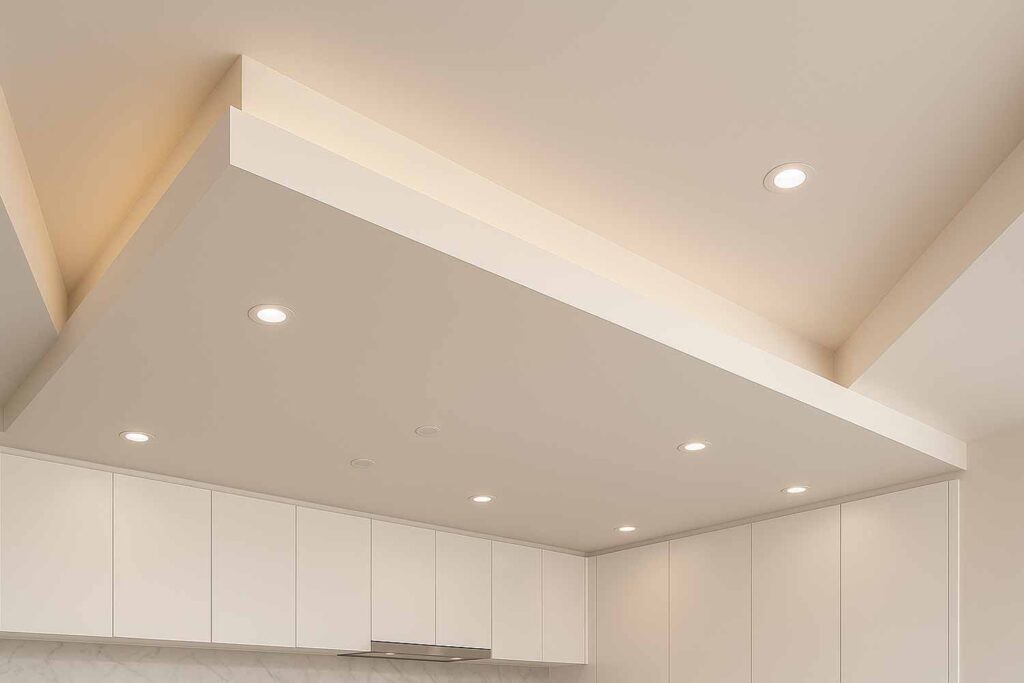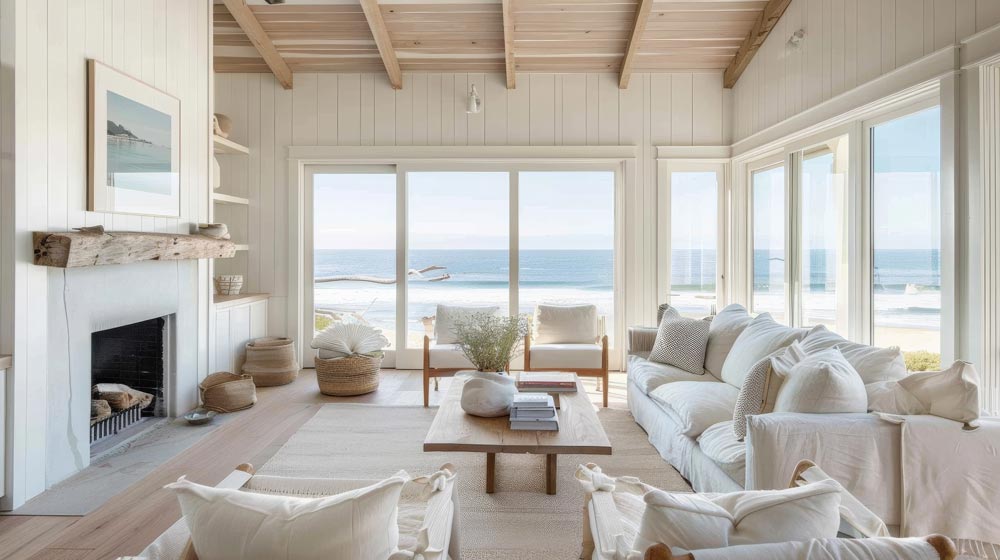
Picture this: you’re reviewing architect plans for your new kitchen, and you spot something labelled “bulkhead” above the cabinets. If you’re scratching your head wondering what exactly this mysterious construction element is, you’re not alone. After two decades in Australian residential construction, I’ve fielded countless questions about bulkheads from confused homeowners who’ve never encountered the term before.
A bulkhead is far more than just a fancy name for a boxed-in ceiling section. It’s a strategic design element that can transform your space whilst solving practical construction challenges. In this comprehensive guide, I’ll walk you through everything you need to know about bulkheads from a home builder‘s perspective, including when they’re essential, when they’re optional, and how to make the right decision for your project.
Whether you’re planning a kitchen renovation, building from scratch, or simply trying to understand your contractor’s recommendations, this guide will give you the professional insights needed to make informed decisions about bulkheads in your Australian home.
What is a Bulkhead in Construction?
Basic Definition and Components
A bulkhead is a non-structural, enclosed ceiling feature that extends downward to create a visual and functional transition between different ceiling heights or to conceal building services. Think of it as a purposeful “step down” in your ceiling that serves both aesthetic and practical functions.
From a construction standpoint, bulkheads are essentially framed boxes attached to the ceiling structure. They’re typically constructed using timber framing (usually 90mm x 45mm studs), covered with plasterboard, and finished to match surrounding ceiling surfaces. The depth can range from 150mm for simple applications to 600mm or more when accommodating substantial services like ducted air conditioning systems common in Australian homes.
What makes bulkheads particularly valuable is their versatility. Unlike purely decorative features, they’re problem-solvers that address real construction challenges whilst enhancing the visual appeal of your space. In Australian conditions, they also provide excellent concealment for cooling systems and moisture management equipment essential for our climate.
Don't Settle for Less—Build Excellence with Dhursan
Bulkhead vs. Soffit: Understanding the Terminology
Many homeowners get confused between “bulkheads” and “soffits,” and frankly, the building industry doesn’t help by using these terms inconsistently. However, there are important distinctions that affect how your project is planned and priced under Australian building standards.
A soffit traditionally refers to the underside of any architectural element – most commonly the area under roof eaves on your home’s exterior. When builders talk about exterior soffits in Australia, they’re discussing ventilation for roof spaces, weather protection from our intense UV exposure, and the finished appearance of your roofline.
RELATED CONTENT: DIFFERENT TYPES OF SHINGLES FOR ROOF
Bulkheads, conversely, are interior features specifically designed to bridge gaps or conceal services. In kitchen applications, a bulkhead creates that clean line between your upper cabinets and the ceiling. The key difference lies in purpose: soffits are typically part of the structural envelope, whilst bulkheads are additions that solve specific interior design and service concealment challenges.
Understanding this distinction matters when discussing your project with contractors, as pricing, materials, and installation methods can vary significantly between the two under Australian building codes.
Structural vs. Non-Structural Elements

Here’s where many homeowners get unnecessarily worried: bulkheads are non-structural elements that don’t bear any load from your home’s frame. They’re purely functional and aesthetic additions that won’t compromise your home’s structural integrity if modified or removed later.
However, don’t let “non-structural” fool you into thinking they’re simple additions. Proper bulkhead construction requires careful attachment to ceiling joists, precise measurement to ensure level installation, and coordination with multiple trades. Poor installation can result in sagging, cracking joints, or alignment issues that become expensive problems years later – particularly problematic in Australia’s variable climate conditions.
The non-structural nature of bulkheads does provide flexibility for future modifications. If your needs change or you want to update the design, bulkheads can be altered without structural engineering concerns – though you’ll still need to consider any services they’re concealing and comply with Australian building regulations.
Types of Bulkheads in Home Construction
Kitchen Bulkheads (Most Common Application)

Kitchen bulkheads represent roughly 80% of residential bulkhead installations in my experience across Australian homes, and there’s good reason for their popularity. Modern Australian kitchens pack an enormous amount of services into relatively compact spaces – rangehoods, downlights, power circuits, water lines for fridges, dishwashers, and increasingly, smart home wiring.
A typical kitchen bulkhead runs along the wall where upper cabinets are installed, creating a clean transition from cabinet tops to ceiling. Standard dimensions usually sit between 300-450mm deep and 200-350mm high, though these measurements adapt to your specific cabinet configuration and ceiling services.
The visual impact cannot be overstated. Without a bulkhead, the gap above kitchen cabinets becomes a dust-collecting void that makes your expensive cabinetry look unfinished. With a properly designed bulkhead, your kitchen achieves that premium, built-in appearance that significantly enhances perceived value in the Australian property market.
Kitchen bulkheads also solve the “what to do with the space above cabinets” dilemma. Rather than awkward decorative items that gather dust, you get clean lines that make your kitchen feel more spacious and organised – particularly important in Australian homes where indoor-outdoor living creates visual connections between spaces.
Bathroom and Laundry Room Bulkheads
Australian bathrooms present unique challenges that make bulkheads particularly valuable. Exhaust fan ducting (essential for moisture control in our humid conditions), heated towel rail wiring, ceiling-mounted heat lamps, and increasingly complex lighting circuits all need concealment. In ensuite bathrooms, bulkheads often house the infrastructure for ceiling-mounted rain showers or mechanical ventilation systems required under Australian building codes.
Laundry rooms benefit enormously from bulkheads when wall-mounted cabinets are installed above front-loading washing machines and dryers. The services for these appliances – power, water, and drainage – can be neatly concealed whilst creating visual continuity with your cabinetry.
Moisture considerations become critical in Australian conditions. Proper vapour barriers and moisture-resistant materials aren’t optional extras – they’re essential for preventing mould and mildew issues common in our climate. I’ve seen too many bathroom bulkheads develop serious problems because corners were cut during construction.
Living Area and Hallway Applications
Open-plan living areas increasingly rely on bulkheads to define spaces without walls – a particularly popular approach in Australian home design. A bulkhead can visually separate your kitchen from living area whilst maintaining that indoor-outdoor flow Australians love. They’re particularly effective when incorporating lighting that highlights the transition between functional zones.
Rumpus rooms benefit significantly from bulkhead installations that create architectural depth and visual interest. Flat ceilings can feel boring sometimes, and bulkheads add essential dimension to these entertainment spaces. The addition of multi-coloured LED strip lights provides the “wow factor” that transforms basic rumpus rooms into exciting family entertainment zones.
Hallway bulkheads serve different purposes, often concealing services that run between rooms or providing mounting points for feature lighting. They’re also valuable for creating architectural interest in otherwise plain ceiling expanses – particularly important in Australian homes where long hallways are common.
Entertainment areas benefit from bulkheads when concealing home theatre wiring, speaker cables, or ducted air conditioning that serves specific zones. The key is ensuring the bulkhead enhances rather than clutters your ceiling lines whilst accommodating Australia’s requirements for climate control.
Why Builders Recommend Bulkhead Ceilings
Concealing Building Services and Utilities
Modern Australian homes contain an astonishing array of services that need to travel through ceiling spaces. Electrical circuits for downlights, exhaust fan ducting, ducted air conditioning systems (essential in most Australian climates), data cabling for NBN and entertainment, security system wiring, and increasingly, smart home infrastructure all compete for space above your ceilings.
Without proper planning, these services create visual chaos. Exposed ducting looks industrial and unfinished in residential settings. Poorly planned service runs can limit your future renovation options whilst failing to meet Australian building standards. Bulkheads provide designated service zones that keep everything organised and accessible for maintenance whilst creating clean sight lines.
The accessibility factor cannot be understated in Australian conditions. When services are properly routed through bulkheads, maintenance becomes straightforward rather than requiring ceiling demolition during scorching summers or wet seasons. I’ve saved homeowners thousands in repair costs by ensuring critical air conditioning and electrical services remain accessible through removable bulkhead panels.
Water services deserve special mention in Australian construction. When hot water lines or hydronic heating systems run above kitchens, bulkheads provide essential concealment whilst allowing access for maintenance or repairs. The alternative – services running through other rooms – creates expensive and disruptive maintenance scenarios.
Creating Clean, Finished Aesthetics
Professional interior designers understand that ceiling lines significantly impact how we perceive space – particularly important in Australian homes where natural light and visual flow are priorities. Inconsistent ceiling heights, visible services, or awkward gaps create visual clutter that makes rooms feel smaller and less refined.
Bulkheads solve these problems by creating intentional, designed ceiling features rather than accidental gaps. They provide opportunities for indirect lighting that enhances ambiance whilst solving practical illumination challenges in Australia’s variable lighting conditions. The shadow lines created by well-designed bulkheads add architectural interest that elevates basic rooms into sophisticated spaces.
In rumpus rooms and entertainment areas, bulkheads create architectural depths that flat ceilings simply cannot achieve. When combined with LED strip lighting – particularly multi-coloured systems – they transform ordinary spaces into impressive entertainment venues that provide real “wow factor” for family gatherings and social occasions.
Colour and finish coordination becomes crucial here. Bulkheads should complement, not compete with, your design scheme. I typically recommend matching ceiling colours for seamless integration, though contrasting finishes can create dramatic impact when executed skilfully – particularly effective in Australian homes where bold design statements are increasingly popular.
Maintenance and Accessibility Benefits
Australian homeowners often overlook long-term maintenance implications when making construction decisions, but our climate makes accessibility particularly important. Bulkheads provide designated service access points that prevent the need for exploratory ceiling demolition when air conditioning, electrical, or plumbing problems arise during peak summer or storm seasons.
Kitchen rangehood systems require periodic cleaning and maintenance – more frequently in Australian conditions where outdoor cooking and higher humidity levels create additional demands. Without bulkhead access, this involves removing ceiling panels or working in cramped roof spaces during extreme temperatures. Properly designed bulkheads include removable panels that make these tasks straightforward year-round.
Electrical maintenance becomes infinitely easier when circuits are properly routed through accessible bulkheads. Whether you’re upgrading lighting, adding new circuits for additional air conditioning zones, or troubleshooting problems, having designated access points saves time and money whilst minimising disruption to finished surfaces.
Building Code Compliance Considerations
Australian building codes increasingly require specific clearances and access provisions for various services, particularly in our demanding climate conditions. Exhaust fan ducting must maintain certain clearances from structural elements. Electrical circuits require accessible junction points that meet AS/NZS standards. Air conditioning systems need service access that doesn’t compromise building seals or energy efficiency ratings.
Bulkheads provide code-compliant solutions for these requirements whilst maintaining aesthetic appeal. They ensure your installation passes inspection whilst avoiding costly remedial work later – particularly important given Australia’s stringent building standards and regular updates to energy efficiency requirements.
Fire safety regulations also impact bulkhead design, particularly around electrical services and exhaust systems. Professional installation ensures compliance with Australian fire safety codes whilst maintaining the visual benefits you’re seeking.
Bulkhead Construction and Installation Process
Materials Used in Bulkhead Construction
Quality bulkhead construction begins with appropriate materials selected for Australian conditions and specific applications. The framing typically uses 90mm x 45mm treated pine studs for moisture-prone areas like bathrooms, or standard framing timber for dry locations. Metal framing becomes necessary in some applications, particularly where termite resistance or fire ratings are critical in Australian construction.
Plasterboard selection impacts both performance and cost in Australian conditions. Standard 10mm plasterboard suits most applications, whilst moisture-resistant variants are essential in bathrooms and laundries, and fire-rated boards may be required around certain services. The quality of plasterboard joints significantly affects the finished appearance – this isn’t an area to economise, particularly given Australia’s temperature variations that affect joint stability.
Insulation within bulkheads serves multiple purposes beyond thermal performance in Australian homes. Sound attenuation becomes important when bulkheads separate spaces or conceal noisy air conditioning equipment. Bulk insulation also prevents condensation issues in temperature-differential situations whilst providing additional acoustic comfort – particularly valuable given Australia’s emphasis on ducted air conditioning systems.
Finishing materials should coordinate with existing ceiling treatments whilst considering Australian conditions. Texture matching can be challenging – newly plastered bulkheads may require specific techniques to blend seamlessly with existing surfaces affected by settling or temperature cycling. This is where experienced plasterers familiar with Australian building conditions earn their fees.
Professional Installation vs. DIY Considerations
Bulkhead installation sits in that challenging middle ground where it appears deceptively simple but requires multiple trade skills for professional results in Australian conditions. Framing, electrical, air conditioning coordination, plastering, and finishing all influence the final outcome whilst meeting Australian building standards.
The critical factor most DIY enthusiasts underestimate is the precision required for level, straight installation in Australia’s variable climate conditions. Bulkheads that are slightly out of level or poorly aligned with existing features become focal points for all the wrong reasons, particularly as buildings settle and materials expand and contract. Professional installation includes laser levelling and precise measurement techniques that ensure perfect integration despite seasonal movement.
Service coordination represents another complexity in Australian construction. Electrical rough-in must occur before plasterboard installation. Air conditioning ducting requires precise planning to avoid interference with framing whilst maintaining efficiency ratings. Lighting integration needs careful consideration of heat dissipation in Australian conditions and access for maintenance during extreme weather periods.
Permit requirements vary by state but often apply to electrical work within bulkheads, particularly when integrating with air conditioning or high-powered lighting systems. Understanding these requirements prevents costly delays and ensures code compliance from the outset.
Timeline and Trade Coordination
Successful bulkhead installation requires careful coordination between multiple trades at specific construction phases in Australian building schedules. Framing occurs during structural completion but before services rough-in. Electrical and air conditioning installation must be completed before plasterboard installation. These timing requirements affect overall project schedules and must be planned around Australia’s seasonal construction patterns.
In renovation projects, coordination becomes more complex as existing services may require temporary relocation or modification – particularly challenging when air conditioning systems can’t be interrupted during extreme weather periods. Dust protection and noise management become important considerations when work occurs in occupied homes.
Quality control checkpoints throughout installation prevent problems that become expensive to rectify later. Frame inspection ensures structural adequacy and service clearances that meet Australian standards. Service rough-in verification confirms compliance with design specifications and energy efficiency requirements. Final inspection validates finishing quality and integration with existing features.
Design Options and Customisation
Standard Dimensions and Proportions
Successful bulkhead design balances functional requirements with visual proportions that enhance rather than overwhelm your space in Australian home contexts. Standard kitchen bulkheads typically measure 300-450mm in depth and 200-350mm in height, though these dimensions adapt to specific cabinet configurations and the substantial ceiling services common in Australian construction.
Proportion rules borrowed from classical architecture apply surprisingly well to bulkhead design in Australian homes. The depth should relate harmoniously to cabinet dimensions – typically one-third to half the upper cabinet depth creates pleasing visual balance. Height considerations include both functional clearances for services and aesthetic proportions relative to Australia’s commonly used ceiling heights of 2.7-3.0 metres.
Room scale significantly influences appropriate bulkhead dimensions in Australian home design. Large open-plan spaces can accommodate more substantial bulkheads that might overwhelm smaller rooms. Ceiling height also affects perception – the standard Australian ceiling heights require careful bulkhead sizing to avoid creating oppressive feelings whilst maintaining service access.
Material Choices and Finishes
Material selection impacts both appearance and longevity whilst addressing Australian climate considerations and maintenance requirements. Standard plasterboard with paint finishes provides the most versatile and cost-effective solution for most applications when properly sealed against humidity. The finish should typically match existing ceiling treatments for seamless integration.
Timber bulkheads create warmth and character but require additional consideration for moisture protection, termite resistance, and expansion in Australian conditions. Engineered timber products offer improved stability and moisture resistance compared to solid timber whilst maintaining the desired aesthetic in our variable climate.
Metal bulkheads suit contemporary design schemes and provide excellent durability, particularly in moisture-prone areas and bushfire-prone regions where fire resistance becomes important. However, they require specialised installation techniques and careful design to avoid industrial appearances in residential settings.
Textured finishes can either enhance or detract from bulkhead effectiveness in Australian homes. Smooth finishes work well with contemporary Australian design trends and maintain clean lines, whilst textured surfaces help camouflage minor imperfections but can appear dated quickly and collect dust in our conditions.
Lighting Integration and Ventilation
Lighting integration transforms bulkheads from purely functional elements into design features that enhance ambiance and functionality in Australian homes. Recessed downlights within bulkheads provide task lighting for kitchen work surfaces whilst creating attractive ceiling interest without conflicting with ceiling fans essential in many Australian regions.
Strip lighting along bulkhead edges creates subtle indirect illumination that enlarges perceived space whilst providing gentle ambient light perfect for Australian indoor-outdoor living environments. LED technology makes these installations energy-efficient and long-lasting in our conditions, though proper heat dissipation remains important for LED longevity in Australian temperatures.
Multi-coloured LED strip lights provide exceptional “wow factor” in rumpus rooms and entertainment areas. These systems can transform flat, boring ceilings into dynamic architectural features that create impressive visual impact for family entertainment and social gatherings. Remote control systems allow easy adjustment for different activities and moods.
Ventilation integration within bulkheads serves both functional and aesthetic purposes in Australian conditions. Exhaust grilles can be neatly integrated into bulkhead designs rather than appearing as afterthoughts. Return air grilles for ducted systems similarly benefit from thoughtful integration that maintains clean lines whilst providing necessary air circulation for comfort and efficiency.
Architectural Style Compatibility
Traditional Australian design schemes benefit from bulkheads that incorporate classical proportions and material selections complementary to existing architectural details. Federation and Victorian influences can be maintained through appropriate moulding integration whilst concealing modern services like air conditioning and contemporary lighting.
Contemporary Australian designs allow for bolder bulkhead statements with contrasting materials, dramatic lighting, and geometric forms that serve as architectural focal points. Clean lines and minimal details typically work best in modern contexts whilst accommodating the substantial service requirements of contemporary Australian homes.
Transitional styles offer flexibility for bulkhead designs that bridge traditional and contemporary elements popular in Australian renovation projects. These applications often incorporate mixed materials and moderate proportions that complement diverse design elements within the same space whilst meeting modern functionality requirements.
Cost Analysis: What to Expect for Bulkhead Installation
Material Cost Breakdown
Understanding bulkhead costs requires breaking down the various components that contribute to final pricing in the Australian market. Basic materials for a standard kitchen bulkhead typically range from $300-600, depending on size and specification requirements. This includes framing timber, plasterboard, fixings, insulation, and basic finishing materials at current Australian prices.
Upgraded materials significantly impact costs in the Australian context. Moisture-resistant plasterboard adds 20-30% to material costs in bathroom applications. Fire-rated materials for certain service applications can double material expenses. Timber or specialty finishes multiply costs substantially compared to standard paint finishes, particularly when using materials suitable for Australian conditions.
Service integration affects material requirements and costs significantly. Electrical rough-in for integrated lighting adds $200-450 in materials plus installation costs. Air conditioning integration may require additional ducting and grilles that impact both material and labour expenses, particularly important in Australian construction where cooling systems are essential.
Labour and Professional Installation Costs
Professional installation costs typically exceed material costs for bulkhead projects in the Australian market. Carpenter framing charges range from 450−900forstandardkitchenapplications,dependingoncomplexityandaccesschallenges.Electricalrough−inadds450−900forstandardkitchenapplications,dependingoncomplexityandaccesschallenges.Electricalrough−inadds375-750 for basic lighting integration, with complex installations including air conditioning coordination commanding premium rates.
Dry lining and plastering represent substantial cost components, particularly when texture matching existing surfaces in Australian conditions. Quality plasterers charge $600-1200 for bulkhead finishing, though this investment proves worthwhile given the visual impact of poor finishing work and the challenges of achieving quality results in variable Australian climates.
Painting costs seem modest but quality preparation and finish application significantly affect final appearance in Australian conditions. Factor $300-600 for professional painting that achieves seamless integration with existing ceiling finishes whilst providing durability against humidity and temperature variations.
Return on Investment Considerations
Kitchen bulkheads typically provide excellent value returns through improved functionality and enhanced aesthetic appeal in the Australian property market. Real estate agents consistently identify well-designed kitchen features as significant value contributors, and bulkheads create that “finished” appearance buyers expect in quality Australian homes.
Bathroom bulkheads offer strong returns through improved functionality and reduced maintenance requirements – particularly valuable in Australian conditions where moisture management and ventilation are critical considerations. The accessibility benefits alone often justify costs through reduced future service call requirements.
Energy efficiency improvements through proper service concealment and insulation can provide measurable utility savings in Australian conditions, though these typically justify bulkhead costs rather than providing significant returns. However, the improved air conditioning efficiency can be substantial in many Australian climates.
Bulkhead Alternatives: Comparing Your Options
Exposed Ceiling Systems
Industrial design trends have popularised exposed ceiling systems showcasing ductwork, conduits, and structural elements as design features. This approach eliminates bulkhead costs whilst creating contemporary character, though it requires careful service coordination to achieve attractive results and may not suit Australian climate requirements for concealed ducting.
Maintenance access improves with exposed systems, though cleaning becomes more complex due to increased surface areas and dust collection points – particularly problematic in Australian conditions where dust accumulation can be substantial. Acoustic performance typically suffers compared to bulkhead installations, which may impact comfort in open-plan configurations popular in Australian homes.
Temperature control can be more challenging with exposed systems as uninsulated services affect thermal performance – a significant consideration in Australian conditions where energy efficiency and climate control are priorities. Sound transmission increases without the acoustic dampening provided by properly insulated bulkheads.
Cabinet Extensions to Ceiling
Extending upper cabinets to ceiling height eliminates the need for bulkheads whilst providing additional storage capacity. This solution works well when ceiling heights allow comfortable access to upper storage areas, typically requiring step ladders for items above standard reach zones in Australian homes with 2.7-3.0m ceilings.
Cost comparisons favour cabinet extensions when additional storage provides value, though cabinetry typically costs significantly more than bulkhead construction per unit area at Australian pricing. Service integration becomes more complex as access requires cabinet removal for maintenance activities – particularly problematic when air conditioning services need regular attention.
Cleaning challenges increase with ceiling-height cabinets as the tops remain accessible and collect dust – a significant issue in many Australian environments. Visual proportions may suffer in rooms with standard Australian ceiling heights where extended cabinets can appear overwhelming.
Decorative Soffits and Crown Moulding
Traditional approaches using decorative soffits and crown moulding create elegant transitions without full bulkhead construction. These solutions work well when service concealment requirements are minimal and architectural character is the primary objective – though less practical for Australian homes with substantial air conditioning requirements.
Cost effective for purely aesthetic applications, decorative solutions become expensive when substantial service concealment is required for the complex systems common in Australian homes. Installation complexity increases significantly when services must be integrated within limited soffit depths.
Maintenance access proves challenging with decorative-only solutions that lack removable panels for service access – particularly problematic in Australian conditions where air conditioning and electrical systems require regular maintenance and occasional emergency access during extreme weather events.
Common Bulkhead Problems and Solutions
Design Mistakes to Avoid
Proportional errors represent the most common bulkhead design mistakes I encounter in Australian construction. Oversized bulkheads overwhelm spaces whilst undersized installations appear inadequate for their purpose – particularly problematic when concealing substantial air conditioning ducting. The solution involves careful measurement and proportion planning relative to room scale and adjacent features.
Poor service coordination creates expensive problems when conflicts arise between different systems common in Australian homes. Air conditioning circuits conflicting with electrical lines, insufficient clearances for large ducting systems, or inadequate access for maintenance all require costly remedial work. Prevention requires detailed planning and trade coordination during design phases.
Inadequate structural attachment leads to sagging, cracking, or failure over time – particularly problematic in Australian conditions with temperature cycling and building movement. Proper fixing to ceiling joists with appropriate fasteners prevents these problems, though access challenges in existing construction sometimes necessitate alternative attachment methods.
Maintenance and Long-term Issues
Moisture infiltration in bathroom installations creates mould growth and structural deterioration when proper vapour barriers and ventilation are omitted – a serious issue in Australian humidity conditions. Regular inspection and prompt attention to minor issues prevent major remedial requirements that can be expensive and disruptive.
Thermal expansion affects bulkhead joints significantly in Australian conditions with substantial temperature variations. Flexible sealants and appropriate joint design accommodate movement whilst maintaining appearance and performance throughout seasonal cycles.
Vibration from mechanical services can cause joint failure and noise transmission – particularly problematic with air conditioning systems operating frequently in Australian conditions. Isolation techniques and proper mounting prevent these problems whilst maintaining service accessibility for maintenance requirements.
Professional Troubleshooting Tips
Crack diagnosis requires understanding the difference between settlement movement and structural problems in Australian building conditions. Minor cracks along joints indicate normal building movement and respond to simple repair techniques. Progressive cracking suggests structural issues requiring professional assessment, particularly important in areas with reactive soils.
Access panel design affects both functionality and appearance whilst accommodating Australian service requirements. Spring-loaded latches provide secure closure whilst allowing easy access for regular maintenance. Magnetic catches offer clean lines but may not provide adequate security for all applications, particularly where vibration from air conditioning equipment is present.
Service identification becomes critical during maintenance or modification activities in Australian homes with complex systems. Proper labelling and documentation prevent accidental damage to concealed systems whilst speeding diagnostic work when problems arise during peak summer periods or storm seasons.
When to Include a Bulkhead in Your Project
New Construction Timing
Early planning phases offer optimal opportunities for bulkhead integration when service routing can be optimised for both functionality and aesthetics in Australian building conditions. Design development should include detailed bulkhead specifications that coordinate with all trades involved in installation, particularly air conditioning contractors essential in Australian construction.
Frame inspection stages require bulkhead framing completion to ensure proper integration with structural elements and service routes. This timing prevents costly modifications when services conflict with bulkhead positions or dimensions, particularly important when accommodating large air conditioning systems.
Service rough-in coordination becomes critical as electrical, plumbing, and mechanical systems must be properly positioned before bulkhead completion. Quality control during these phases prevents expensive remedial work and ensures proper system performance in Australian conditions where service reliability is essential.
Transform Your Vision into Reality with Dhursan Construction
Renovation and Remodelling Considerations
Existing service assessment determines renovation complexity and cost implications in Australian homes often requiring substantial service upgrades. Air conditioning systems that require relocation or modification significantly impact project budgets and timelines. Professional assessment prevents unpleasant surprises during construction phases.
Structural integration in existing Australian construction may require alternative attachment methods when standard ceiling joist fixing proves inadequate due to building age or design. Engineering assessment ensures adequate support whilst maintaining existing structural integrity and meeting current building standards.
Dust and noise management become critical considerations in occupied Australian homes during renovation projects, particularly during extreme weather when families rely on air conditioning and cannot easily relocate temporarily. Proper containment and scheduling minimise disruption whilst protecting existing finishes and family comfort.
Professional Recommendations
Consultation timing affects design quality and cost control when professional input occurs during early planning phases rather than reactive problem-solving during construction. Investment in quality design services typically provides significant returns through optimised functionality and reduced construction costs, particularly important in Australian conditions with complex service requirements.
Trade qualification verification ensures competent installation that meets Australian building standards and achieves intended performance. Proper licensing and insurance protection prevent costly liability issues whilst ensuring quality workmanship that performs reliably in Australian conditions.
Warranty considerations should address both materials and workmanship for comprehensive protection in Australian conditions. Understanding coverage limitations and maintenance requirements preserves warranty validity whilst ensuring long-term satisfaction despite challenging climate conditions.
Key Takeaways: Making the Right Bulkhead Decision
After guiding hundreds of Australian homeowners through bulkhead decisions, the most successful projects share common characteristics: early planning, realistic budgeting, and clear understanding of intended benefits in Australian conditions. Bulkheads should solve specific problems whilst enhancing your space, not simply follow trends or meet arbitrary aesthetic preferences.
The decision framework I recommend evaluates three critical factors: functional necessity, visual impact, and long-term value in the Australian context. If your project requires extensive service concealment (particularly air conditioning systems), bulkheads often provide the most cost-effective solution. When visual integration of cabinetry is important, bulkheads create that premium appearance that distinguishes quality installations in the Australian market.
Budget considerations should include both initial installation costs and long-term maintenance benefits in Australian conditions. Quality bulkhead installation provides decades of service whilst improving accessibility for future maintenance requirements – particularly valuable when air conditioning systems need regular attention in our demanding climate.
Before proceeding with your bulkhead project, consider these essential questions:
- What services require concealment and how will future access be maintained in Australian conditions?
- How do proposed bulkhead dimensions relate to room proportions and adjacent features?
- What lighting or ventilation integration opportunities could enhance functionality and create “wow factor”?
- How will material and finish selections coordinate with existing design elements whilst performing reliably in Australian conditions?
Professional consultation during early planning phases typically provides significant value through optimised design solutions and realistic cost projections for Australian conditions. Whether you’re building new or renovating existing space, the right bulkhead solution balances functional requirements with aesthetic goals whilst providing lasting value for your investment.
If you’re considering bulkheads for your next project, we’d be delighted to discuss your specific requirements and provide professional recommendations tailored to Australian conditions and your needs. Our experienced team can help you navigate the design and installation process, ensuring your bulkhead solution provides optimal functionality and visual appeal for years to come.
Looking to explore bulkhead options for your Australian home? Contact us today for a consultation that identifies the best solution for your space, budget, and lifestyle requirements whilst meeting Australian building standards and climate considerations.




